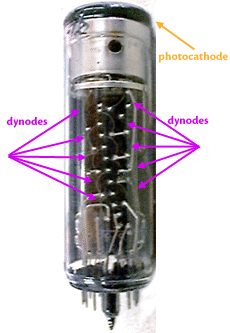|
How does one see the effect of a single electron?
We saw that when a photon strikes the photocathode, it ejects an electron. It is difficult to measure the effect of a single electron using standard laboratory instruments such as oscilloscopes and voltmeters. To have a measurable effect, the initial electron needs to be converted to between 104 and 105 electrons.
Photomultiplier tubes contain a chain of dynodes. (The tube in the photo to the left has ten dynodes). Each dynode in the chain is held at a potential relative to the next, and is coated with secondary emissive material. Secondary emission is the process by which a electron strikes a metal, and ejects other electrons from the metal by transferring some of its kinetic energy to them. These secondary electrons are accelerated from dynode to dynode, and each secondary electron causes the emission of several other electrons.
Let's investigate this further!
|

